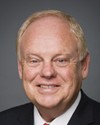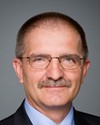We ran a pilot project this summer and did 550 square kilometres. There is a plan to do an identical project next summer during the time when the Northwest Passage is open, which is approximately six weeks in the summer, roughly in the latter part of August and the first part of September.
RADARSAT data from RADARSAT-2 was used to get the coastlines at very high resolution. So we ended up with a three-dimensional image of the coastline and the rock outcrop. Then DFO flew in aircraft with the latest lidar instrument, which made bathymetry measurements. Depending on the clarity of the water, it measures down to 50 metres, so you use the lidar to do the intermittent areas of rock and shallow water, and in addition, launched off the Louis S. St. Laurent , they did underwater surveys with sonar down to a depth of 200 metres.
The concept of this pilot project is to show, again to the leadership of the country, that this is the best way to chart the Arctic, because right now it's only 10% charted. Then there would be a proposal made to cabinet about how to do that. It would take 10 to 15 years to chart the entire Arctic, using the latest and greatest technology.
Obviously, using the space assets it doesn't take that long to get the coastline to the resolution that we're looking at, or the rock outcrops, but the lidar and the sonar take longer, given that you're working six weeks a year, when it's open.






